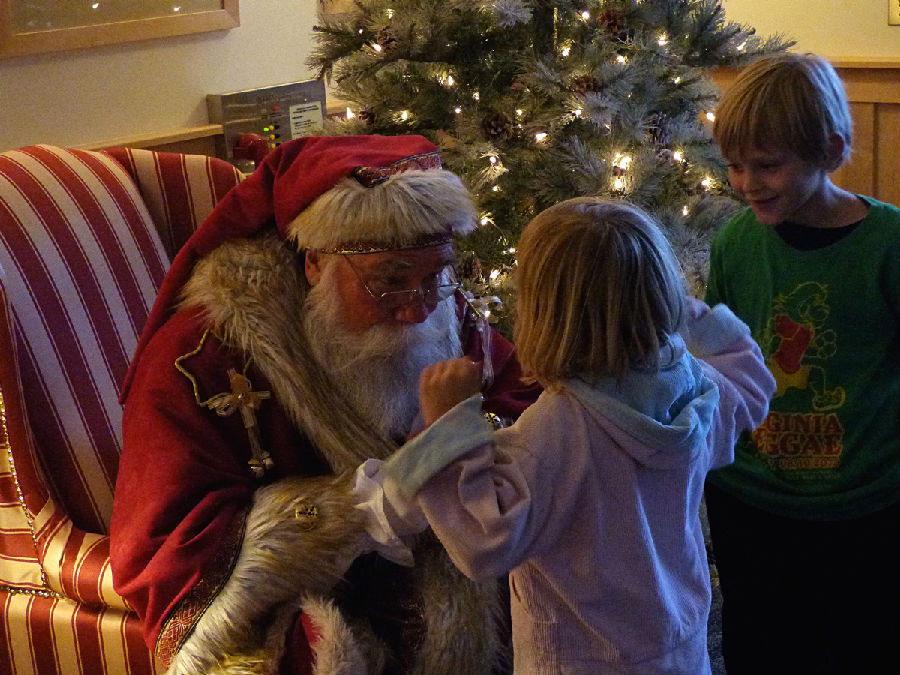(单词翻译:单击)
听力文本
Now, Words and Their Stories from VOA Learning English.
This week, we have a special program for the holiday season. It is a show recorded many years ago by Maurice Joyce. He worked as an announcer at the Voice of America, and presented Words and Their Stories among other programs in Special English.
Today he tells about a popular personality at this time of year: Santa Claus!
We hope you enjoy this blast from the past. Here is Maurice Joyce.
Santa Claus is someone who will remain in the hearts of children forever. He is the make-believe person who brings toys and other gifts to children at Christmas.
To grown-ups, he is a special symbol of goodwill and selfless giving. Santa Claus also has some other names: Saint Nicholas, St. Nick, Kris Kringle, Pelznickel.
Two of his names -- Santa Claus and Saint Nicholas -- both come from the Dutch who settled in New York long ago. The Dutch believed Saint Nikolas gave gifts to children. They honored this kindly saint with a yearly festival on December sixth.
The English-speaking people who lived nearby greatly enjoyed Dutch festivals. And they brought the saint and the custom of giving gifts into their own celebration at Christmas time. The Dutch spoke the name "Saint Nikolaas" very fast. It sounded like "sinterklaas." And so, when the English said this word, it sounded like Santa Claus.
West of New York, in Pennsylvania, many German farmers had also heard of Saint Nikolas. But they called him Pelznickel. This word came from "pelz," meaning fur, and "nickel" for Nicholas. And so, to the Germans of Pennsylvania, Saint Nicholas or Pelznickel was a man dressed in fur who came once a year with gifts for good children.

Soon, people began to feel that the love and kindness Pelznickel brought should be part of a celebration honoring the Christkindl, as the Germans called the Christ child. After a time, this became Kris Kringle.
Later, Kris Kringle became another name for Santa Claus himself.
Whatever he is called, he is still the same short, fat, jolly old man with a long beard, wearing a red suit with white fur.
The picture of Santa Claus as we see him came from Thomas Nast. He was an American painter born in Bavaria.
He painted pictures for Christmas poems. Someone asked him to paint a picture of Santa Claus. Nast remembered when he was a little boy in southern Germany. Every Christmas, a fat old man gave toys and cakes to the children. So, when Nast painted the picture, his Santa Claus looked like the kindly old man of his childhood.
And through the years, Nast's painting has remained as the most popular picture of Santa Claus.
Santa can be seen almost everywhere in large American cities during the Christmas season. Some stand on street corners asking for money to buy food and gifts for the needy. Others are found in stores and shopping centers. It is easy to find them by the long lines of children waiting to tell Santa what they want for Christmas.
And that is our special Words and Their Stories for Christmas. I'm Anna Matteo, wishing you and your loved ones a very happy holiday season!
重点解析
1.come from 来自;来源于
Words like cow, sheep and swine come from the English-speaking farmers.
有些词如公牛,羊和猪,源自说英语的农民。
2.heard of 听过;听说过
My mother heard of this school through Leslie.
我母亲是从莱斯利那里知道这所学校的。
3.dress in 穿着;穿……的服装
She used to dress in jeans.
她过去常穿牛仔裤。
参考译文
欢迎收听VOA慢速英语《词汇掌故》。
本周,我们制作了一档特别的节日节目,这是莫里斯·乔伊斯多年前录制的一期节目。他在美国之音担任播音员,主持《词汇掌故》等多个节目。
今天,他会讲述一个在每年这个时候都非常受人们欢迎的人物:圣诞老人!
希望你们能从这个老节目中享受到快乐时光,下面是莫里斯·乔伊斯。
圣诞老人永远留在孩子们心中,他是一个虚构的人物,在圣诞节给孩子们带来玩具和其他礼物。
对成年人来说,他是善意和无私奉献的特殊象征。圣诞老人还有其他一些名字:圣尼古拉斯、圣尼克、克里斯·克林格尔、佩尔兹尼克。
他的两个名字——圣诞老人和圣尼古拉斯——都来自很久以前在纽约定居的荷兰人。荷兰人相信,圣尼古拉给孩子们送礼物。他们每年12月6日举行一次节日,来纪念这位仁慈的圣人。
住在附近的讲英语者非常喜欢荷兰的节日,他们在圣诞节时把这位圣人和送礼的习俗带进自己的庆祝活动中。荷兰人说“圣尼古拉”这个名字时,讲得很快,听上去像“辛特拉斯”。所以,英国人说这个词时,听起来就像“Santa Claus”(圣诞老人)。
在纽约西部的宾夕法尼亚州,许多德国农民也听说过圣尼古拉。但他们把他叫作佩兹尼克,这个词来自“pelz”,意思是毛皮,“nickle”是尼古拉斯的意思。因此,对宾夕法尼亚州的德国人来说,圣尼古拉斯或佩尔兹尼克尔是一个穿着皮草的人,他每年都会给好孩子送礼物。
很快,人们开始觉得佩尔兹尼克尔带来的爱和仁慈应该是纪念基督的一部分,德国人称之为基督之子。过了一段时间,就变成了克里斯·克林格尔。
后来,克里斯·克林格尔成了圣诞老人的另一个名字。
不管叫什么名字,他还是那个留着长胡子、矮胖胖、快活的老头儿,穿着一身带有白皮毛的红套装。
我们看到的圣诞老人的图像来自托马斯·纳斯特,他是一位出生在巴伐利亚的美国画家。
他为圣诞诗作画,有人请他画一幅圣诞老人的画像。纳斯特记得他小时候在德国南部,每年圣诞节,一个胖老头会给孩子们送玩具和蛋糕。所以,当纳斯特画这幅画时,他的圣诞老人看起来就像他童年时那位和蔼可亲的老人。
多年来,纳斯特的画一直是最受欢迎的圣诞老人画像。
圣诞节期间,在美国大城市几乎随处可见圣诞老人。有些站在街角,要钱给穷人买食物和礼物,其他的则在商店和购物中心。很容易找到他们,只要看看那一排排等待告诉圣诞老人圣诞节想要什么礼物的孩子们就行了。
这是《词汇掌故》圣诞节特别节目,我是安娜·马特奥,祝你和所爱的人节日快乐!


